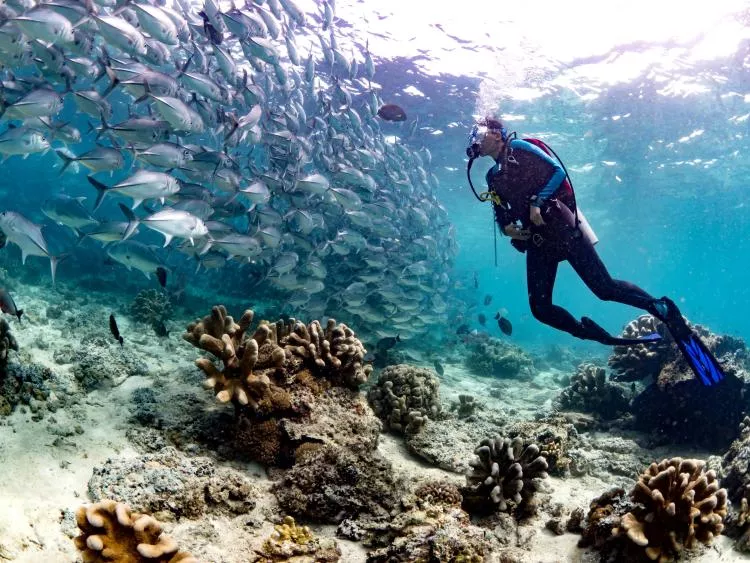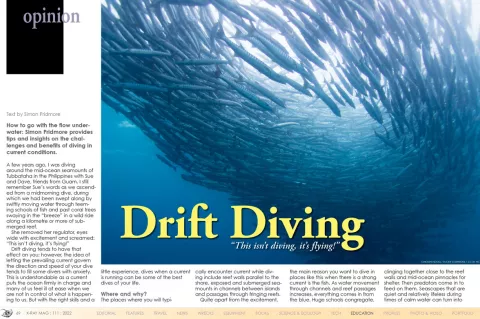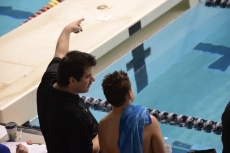How to go with the flow underwater: Simon Pridmore provides tips and insights on the challenges and benefits of diving in current conditions.
Contributed by
A few years ago, I was diving around the mid-ocean seamounts of Tubbataha in the Philippines with Sue and Dave, friends from Guam. I still remember Sue’s words as we ascended from a midmorning dive, during which we had been swept along by swiftly moving water through teeming schools of fish and past coral trees swaying in the “breeze” in a wild ride along a kilometre or more of submerged reef.
She removed her regulator, eyes wide with excitement and screamed:
“This isn’t diving, it’s flying!”
Drift diving tends to have that effect on you; however, the idea of letting the prevailing current govern the direction and speed of your dive tends to fill some divers with anxiety. This is understandable as a current puts the ocean firmly in charge and many of us feel ill at ease when we are not in control of what is happening to us. But with the right skills and a little experience, dives when a current is running can be some of the best dives of your life.
Where and why?
The places where you will typically encounter current while diving include reef walls parallel to the shore, exposed and submerged seamounts in channels between islands and passages through fringing reefs.
Quite apart from the excitement, the main reason you want to dive in places like this when there is a strong current is the fish. As water movement through channels and reef passages increases, everything comes in from the blue. Huge schools congregate, clinging together close to the reef walls and mid-ocean pinnacles for shelter. Then predators come in to feed on them. Seascapes that are quiet and relatively lifeless during times of calm water can turn into phenomenal action-filled aquatic circuses when the current picks up.
Current signs
From the surface, the tell-tale signs of a strong current are whirlpools interspersed with suspicious patches of calm. A wavy line of calmer-than-usual water running parallel to the coast is a good indication that there is a current running along the shore. Underwater in the tropics, you know that a site is current-swept if there are plenty of gorgonian fans and sea whips there. The more water that moves past these corals and brings them nourishment, the larger they grow. If you see them permanently bent like trees in a high wind, you know that currents there are often very strong.
Going with the flow
On a drift dive, the best advice is to go with the flow, resist the instinctive urge to use your fins for anything more than balance, tuck your arms in and enjoy the ride.
The ability to anticipate, quick reactions and good control of your buoyancy and positioning in the water are useful skills to have if you want to stay on course and avoid damaging either yourself or the reef. A good drift diver needs to be something of a slalom skier and know how to correct direction swiftly and smoothly.
Make yourself as streamlined as possible, and secure and tuck in all your hoses and accessories. You will be moving fast, close to an uneven surface, and you do not want anything to get caught as you pass. Wear a full-length wetsuit with neoprene on your arms and legs to protect yourself from harm in case you do brush against something.
Follow the fish
To get the best idea of how the current is running, look at the fish. They are the experts.
When there is no current, the fish—large and small—will be milling around all over the place. In a mild current, they will all be facing the same way, into the current, and the stronger the current becomes, the closer to the reef they will be.
As the current increases in strength, the little fish will be spread out close to the coral, waving their tails like crazy to stay in position. When it gets really strong, they will be down in and among the coral structures, and even the big fish will be hovering very close to the reef.
If you want to take a break from the current during a drift dive, use these big fish as your guide. You will find them behind large rocks or outcrops where they can shelter from the flow. If you are a photographer, this is your opportunity to get up close, as they will be reluctant to move out of their hiding places.
Staying still
When you find a hot spot on the reef or wall where there is lots of action, you may want to stick around and not let the current carry you away immediately. So, you need to find a way of staying in place. Finning like crazy against the current will tire you out quickly. Instead, you can grab hold of a solid bit of rock—after first making sure that it really is a rock—or, if you have one, you can deploy your reef hook.
A reef hook normally consists of a length of cord passed through the eye of a blunt-ended curved piece of stainless steel that looks like a large fishing hook. A clip is attached to the other end of the cord. The idea is that you wedge the hook into a crevice in a reef, snap the clip on to a BCD harness D-ring and just hang in the current, held in place, effortlessly enjoying the view. Do not be discouraged if at first you find it difficult to find your balance. It may take a little practice over a few dives for you to get completely comfortable with the technique.
Downcurrents
While I am on the topic, I should offer a few tips on dealing with another phenomenon that you may encounter when you dive in a current-fed area. Just the mention of a downcurrent is enough to bring many divers out in a cold sweat as they visualise themselves getting caught by an irresistible force that will drag them down into the abyss with no opportunity for escape.
The natural response when confronted with a downcurrent is to panic, but there is no need. Just as a long-shore current is a relatively narrow river in the ocean, a downcurrent is a waterfall.
When you encounter one, the first thing to do is get out of its pull. To do this, move closer to the reef wall so that the contours offer you shelter. Once out of the flow, relax, exhale, take a few full deep breaths to calm yourself, check your air supply, depth and decompression status, look around you and plan your next move.
As I mentioned before, use the marine life as your guide. If things look calm farther along the wall, then continue your dive in that direction. If not, then swim laterally out away from the wall towards the blue. If initially you find yourself being carried a little deeper as you pass through the “waterfall,” just stay calm and keep swimming. Before long, you will emerge from its pull and can ascend to make your way back to the reef top.
It is not a good idea to fight a downcurrent. It is a struggle you cannot win. The oft-quoted tactic of inflating your BCD to counteract its efforts to carry you down is potentially dangerous as the downcurrent may suddenly release you from its hold and you will find yourself on a runaway ascent to the surface—something that may do you much more harm than the downcurrent ever could.



























